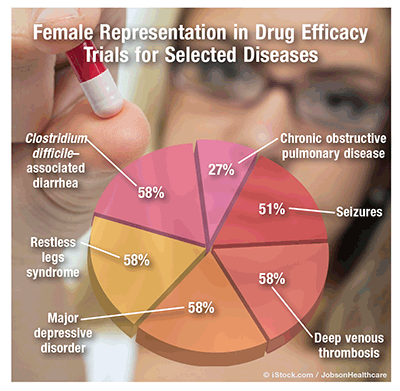US Pharm. 2015;40(10):21.
Women have been disproportionately excluded from clinical trials of new drugs and devices, yet gender differences are observed in response to many drugs. Women have a 1.5- to 1.7-fold greater risk of developing an adverse drug reaction, and over the past few decades several drugs have been withdrawn from the market for gender-based adverse events. Current regulatory policy pertaining to the mandatory inclusion of women in clinical trials applies only to NIH-funded research, not to industry-sponsored studies. However, on the whole, the industry values diversity in clinical-trial enrollment. A 2013 FDA report shows that the number of women participating in clinical trials varies by disease state.

Drug Efficacy Trials: Clinical trials for systemic lupus erythematosus (94%) had the highest proportion of women, followed by trials for head lice (88%) and hereditary angioedema (64%). In clinical trials concerning Clostridium difficile–associated diarrhea, restless legs syndrome, major depressive disorder, and deep venous thrombosis, women constituted 58% of the study population (in each trial). Closely following in terms of inclusion of female subjects were studies on age-related macular degeneration (57%), iron overload (56%), Hodgkin lymphoma (54%), anaplastic lymphoma kinase–positive non–small cell lung cancer (52%), and seizures (51%). Drug efficacy trials in which 40% to 50% of subjects were women included those on myelofibrosis (45%), medullary thyroid cancer (43%), acute lymphoblastic leukemia (43%), melanoma (42%), and anaplastic large cell lymphoma (42%). Clinical trials with the smallest numbers of women included those for HIV (25%) and chronic obstructive pulmonary disease (27%).
Medical Devices: Medical devices are subject to gender bias based on significant physical differences between men and women. The inclusion rate of women in clinical testing was highest for medical devices used to treat fecal incontinence (88%), followed by devices used for treatment of intracranial aneurysms (85%). In clinical testing of medical devices for osteoarthritis, 58% of subjects were female, and in testing for hip prosthetics, 57% were female. Among the devices in which the proportion of women in clinical trials was <50% were iliac stents (45%), pacemakers (35%), and defibrillators for nonparoxysmal atrial fibrillation (35%).
Implications: Clinical-trial participation rates for women have improved in recent decades, with enrollment averaging 50% in late-phase trials, but rates remain between 21% and 32% for early-stage research. In 2011, >18,205 clinical trials were seeking volunteers, creating opportunities for women to participate in the development of new treatment protocols. However, women are underserved in their access to quality medical care and are less likely to know about or enroll in clinical trials.
To comment on this article, contact rdavidson@uspharmacist.com.






